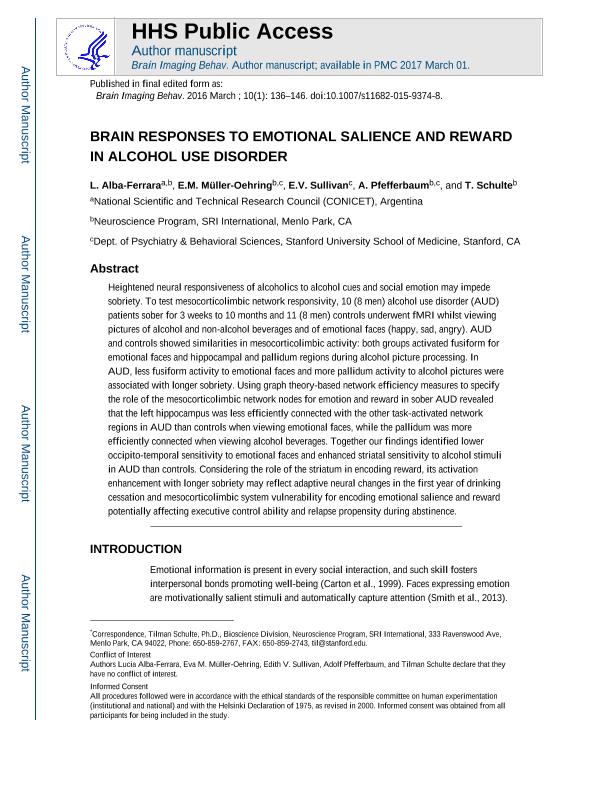Mostrar el registro sencillo del ítem
dc.contributor.author
Alba Ferrara, Lucia M

dc.contributor.author
Müller Oehring, E. M.
dc.contributor.author
Sullivan, E. V.
dc.contributor.author
Pfefferbaum, A.
dc.contributor.author
Schulte, T.
dc.date.available
2018-03-09T19:29:41Z
dc.date.issued
2016-03
dc.identifier.citation
Alba Ferrara, Lucia M; Müller Oehring, E. M.; Sullivan, E. V.; Pfefferbaum, A.; Schulte, T.; Brain responses to emotional salience and reward in alcohol use disorder; Springer; Brain Imaging And Behavior; 10; 1; 3-2016; 136-146
dc.identifier.issn
1931-7557
dc.identifier.uri
http://hdl.handle.net/11336/38444
dc.description.abstract
Heightened neural responsiveness of alcoholics to alcohol cues and social emotion may impede sobriety. To test mesocorticolimbic network responsivity, 10 (8 men) alcohol use disorder (AUD) patients sober for 3 weeks to 10 months and 11 (8 men) controls underwent fMRI whilst viewing pictures of alcohol and non-alcohol beverages and of emotional faces (happy, sad, angry). AUD and controls showed similarities in mesocorticolimbic activity: both groups activated fusiform for emotional faces and hippocampal and pallidum regions during alcohol picture processing. In AUD, less fusiform activity to emotional faces and more pallidum activity to alcohol pictures were associated with longer sobriety. Using graph theory-based network efficiency measures to specify the role of the mesocorticolimbic network nodes for emotion and reward in sober AUD revealed that the left hippocampus was less efficiently connected with the other task-activated network regions in AUD than controls when viewing emotional faces, while the pallidum was more efficiently connected when viewing alcohol beverages. Together our findings identified lower occipito-temporal sensitivity to emotional faces and enhanced striatal sensitivity to alcohol stimuli in AUD than controls. Considering the role of the striatum in encoding reward, its activation enhancement with longer sobriety may reflect adaptive neural changes in the first year of drinking cessation and mesocorticolimbic system vulnerability for encoding emotional salience and reward potentially affecting executive control ability and relapse propensity during abstinence.
dc.format
application/pdf
dc.language.iso
eng
dc.publisher
Springer

dc.rights
info:eu-repo/semantics/openAccess
dc.rights.uri
https://creativecommons.org/licenses/by-nc-sa/2.5/ar/
dc.subject
Alcohol Use Disorder
dc.subject
Emotion
dc.subject
Face Processing
dc.subject
Fmri
dc.subject
Functional Connectivity
dc.subject
Mesocorticolimbic
dc.subject
Reward
dc.subject
Sobriety
dc.subject.classification
Inmunología

dc.subject.classification
Medicina Básica

dc.subject.classification
CIENCIAS MÉDICAS Y DE LA SALUD

dc.title
Brain responses to emotional salience and reward in alcohol use disorder
dc.type
info:eu-repo/semantics/article
dc.type
info:ar-repo/semantics/artículo
dc.type
info:eu-repo/semantics/publishedVersion
dc.date.updated
2018-03-09T14:47:30Z
dc.journal.volume
10
dc.journal.number
1
dc.journal.pagination
136-146
dc.journal.pais
Alemania

dc.journal.ciudad
Berlin
dc.description.fil
Fil: Alba Ferrara, Lucia M. Fundación de Lucha Contra Los Trastornos Neurologicos y Psiquiatricos En Minorias. Instituto San Lazaro de Neurociencias. Unidad de Resonancia Magnetica; Argentina. Consejo Nacional de Investigaciones Científicas y Técnicas; Argentina
dc.description.fil
Fil: Müller Oehring, E. M.. University of Stanford; Estados Unidos
dc.description.fil
Fil: Sullivan, E. V.. University of Stanford; Estados Unidos
dc.description.fil
Fil: Pfefferbaum, A.. Stanford Research Institute; Estados Unidos
dc.description.fil
Fil: Schulte, T.. Stanford Research Institute; Estados Unidos
dc.journal.title
Brain Imaging And Behavior

dc.relation.alternativeid
info:eu-repo/semantics/altIdentifier/url/http://link.springer.com/article/10.1007/s11682-015-9374-8
dc.relation.alternativeid
info:eu-repo/semantics/altIdentifier/doi/http://dx.doi.org/10.1007/s11682-015-9374-8
Archivos asociados
